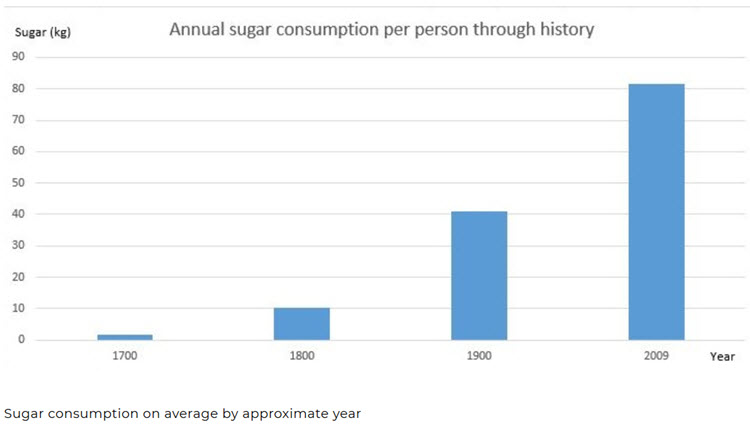Sugar Consumption Keeps Doubling Over Time

It's no secret that we all consume too much sugar these days. The sugar industry is a huge industry and the processed food industry plays along. The NHS say that we should not be consuming more than 30 g a day. The real truth is that we consume four times that amount.
But how did we get here? Sugar consumption hasn’t always been so high. It’s time to go back to basics: asking, how much sugar did people eat 100 years ago?
IFL Science reports that sugarcane is now the world’s third most valuable crop after cereals and rice, occupying 26,942,686 hectares of land across the globe. However, it wasn’t always so widespread. Several hundred years ago, sugar formed a very small part of the human diet, which was much more closely premised on pulses, fruits and vegetables that would be foraged plus local animals hunted.
Initially during its mass production, sugar was believed to be beneficial to health, and was only available to the elite classes who could afford it. Sugar and Sweetener Guide explains, “By 1700 average consumption of sugar in the developed world was approximately 4 pounds per annum and this accounted for less than 1 per cent of calorie intake. By 1800 this had risen to approximately 18 pounds and by 1900 it was 60 pounds.” However, it wasn’t long after its popularization that experts began to question the value of sugar for human health.
“Sugar, syrup, and candy are sometimes made from corn by a peculiar process, by means of which the starch of the corn is changed into glucose, and a kind of sugar not so sweet or healthful as sugar made from sugar-cane or sugar beets. This sugar is quite apt to ferment, or sour, and decay within the bowels, thus causing disease.”
.

image source
Studies show that the modern-day urge for sugar is a “craving you can’t always trust. A sugar craving is usually due to an imbalance in your gut bacteria or a sign of a blood sugar crash. If you rebalance your gut bacteria and you’ll find your sugar cravings will go down dramatically.” Along with addressing the cause of sugar cravings, it is essential for consumers and producers alike to recognize the dangers of sugar, from obesity to diabetes, and provide healthier and more sustainable alternatives in shops and restaurants everywhere.
Low carb diets address the sugar problem and it is amazing how the sugar craving goes away.
featured image came from pixabay.com
For a lot more on sugar history go to the source article.
Discover the sugar alternatives.
Sugar Alternatives




Leave a Reply